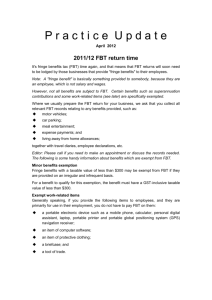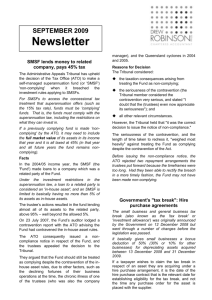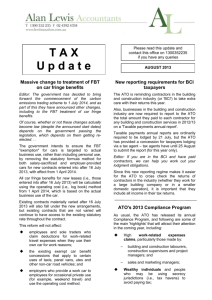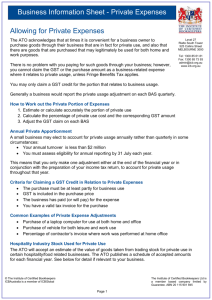Taxwise June 2015
advertisement
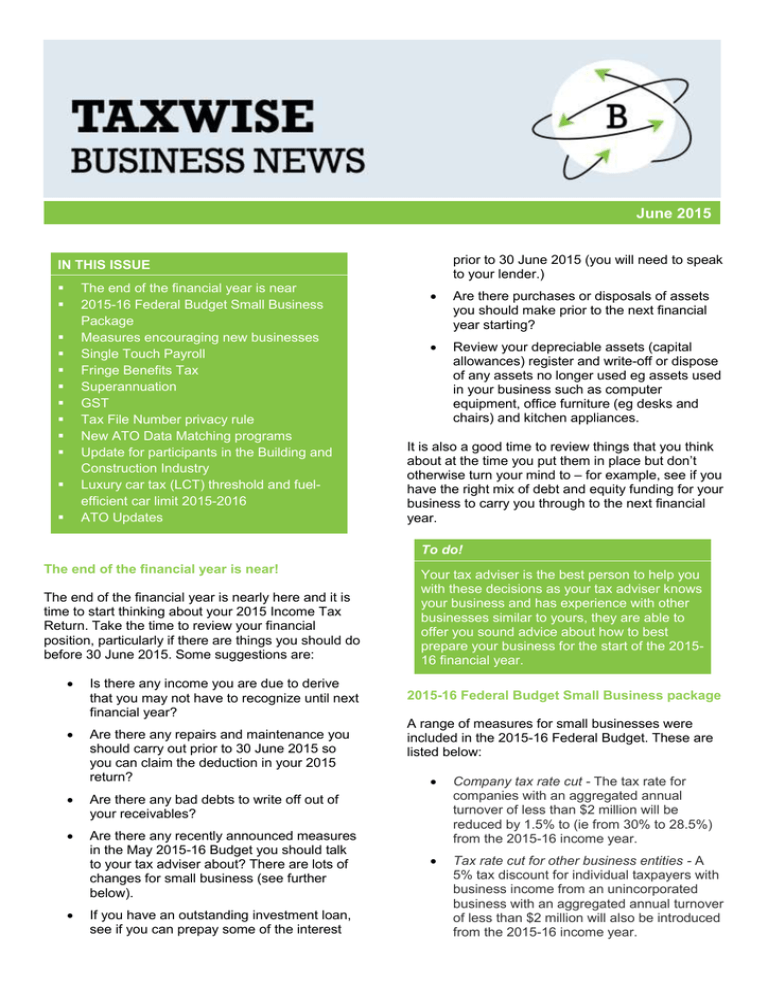
June 2015 prior to 30 June 2015 (you will need to speak to your lender.) IN THIS ISSUE The end of the financial year is near 2015-16 Federal Budget Small Business Package Measures encouraging new businesses Single Touch Payroll Fringe Benefits Tax Superannuation GST Tax File Number privacy rule New ATO Data Matching programs Update for participants in the Building and Construction Industry Luxury car tax (LCT) threshold and fuelefficient car limit 2015-2016 ATO Updates Are there purchases or disposals of assets you should make prior to the next financial year starting? Review your depreciable assets (capital allowances) register and write-off or dispose of any assets no longer used eg assets used in your business such as computer equipment, office furniture (eg desks and chairs) and kitchen appliances. It is also a good time to review things that you think about at the time you put them in place but don’t otherwise turn your mind to – for example, see if you have the right mix of debt and equity funding for your business to carry you through to the next financial year. To do! The end of the financial year is near! The end of the financial year is nearly here and it is time to start thinking about your 2015 Income Tax Return. Take the time to review your financial position, particularly if there are things you should do before 30 June 2015. Some suggestions are: Is there any income you are due to derive that you may not have to recognize until next financial year? Are there any repairs and maintenance you should carry out prior to 30 June 2015 so you can claim the deduction in your 2015 return? Are there any bad debts to write off out of your receivables? Are there any recently announced measures in the May 2015-16 Budget you should talk to your tax adviser about? There are lots of changes for small business (see further below). If you have an outstanding investment loan, see if you can prepay some of the interest Your tax adviser is the best person to help you with these decisions as your tax adviser knows your business and has experience with other businesses similar to yours, they are able to offer you sound advice about how to best prepare your business for the start of the 201516 financial year. 2015-16 Federal Budget Small Business package A range of measures for small businesses were included in the 2015-16 Federal Budget. These are listed below: Company tax rate cut - The tax rate for companies with an aggregated annual turnover of less than $2 million will be reduced by 1.5% to (ie from 30% to 28.5%) from the 2015-16 income year. Tax rate cut for other business entities - A 5% tax discount for individual taxpayers with business income from an unincorporated business with an aggregated annual turnover of less than $2 million will also be introduced from the 2015-16 income year. Increase to the instant asset write-off threshold to $20,000 - The threshold below which small businesses can claim an immediate deduction for the cost of assets will be temporarily increased from $1,000 to $20,000. This applies to assets purchased from Budget night onwards. Small business simplified depreciation pool – Assets costing more than $20,000 will be able to be put in the small business simplified depreciation pool. If the pool balance falls below $20,000, it will be able to be written off immediately. The rules preventing small businesses from re-entering the simplified depreciation regime for five years after opting not to use it will also be temporarily suspended. This applies from Budget night onwards. To do! If you run a small business with aggregated annual turnover of less than $2 million, see your tax adviser to see if you are eligible for these changes. There may be some planning that you need to do now for the start of the 2015-16 financial year. Measures encouraging new businesses Some new measures will be introduced to make it easier to register a new business. These include: Professional expenses – new businesses will be able to claim an immediate deduction for professional expenses (eg for the cost of advice from lawyers, accountants and other professionals) associated with starting a business from the 2015-16 income year. Employee share schemes - Further changes will be made to the taxation of employee share schemes. There is already a Bill in Parliament making changes to the rules; the Budget changes are in addition to the ones already coming. New CGT relief - Capital gains tax relief will be available to small businesses for a CGT liability arising from the alteration of their legal structure from the 2016-17 income year. Electronic devices and FBT - The fringe benefits tax exemption for portable electronic devices used primarily for work purposes will be expanded from 1 April 2016. Preparing for drought - Primary producers will be able to claim accelerated depreciation for water facilities, fodder storage and fencing from 1 July 2016. There is no legislation for these measures yet. However, the ATO has already issued some guidance in relation to the increased instant asset write-off threshold amount and some of the other changes. Visit the ATO website for guidance. Note! From 1 July 2017, the $20,000 threshold for the immediate deduction of assets and the value of the pool will revert back down to $1,000. Also, the suspension of the rules preventing re-entry into the small business simplified depreciation pool will be lifted. business registration processes will be streamlined with a single online portal (business.gov.au) developed for business and company registration, making it much easier to register a new business. A new business will no longer need an Australian Company Number or business Tax File Number. It will be able to use its Australian Business Number to interact with the ATO and ASIC. The new portal (expected to be implemented by mid-2016) will provide all the relevant information clearly and will have integrated customer support; and a regulatory framework to facilitate the use of crowd-source equity funding will be implemented, including simplified reporting and disclosure requirements, to help small businesses access innovative funding sources. Tip! If you are planning on starting a new business, you should speak to your tax adviser to see if you should wait for these new measures to be introduced before you set up your business. Single Touch Payroll On 28 December 2014, the Minister for Small Business, Bruce Billson, and the Assistant Treasurer, Josh Frydenberg, announced that the Government will cut red tape for employers by simplifying tax and superannuation reporting obligations through Single Touch Payroll. Under Single Touch Payroll, employers will be required to electronically report payroll and super information to the ATO when employees are paid, using Standard Business Reporting-enabled software. The ATO has now published a discussion paper on Single Touch Payroll containing a number of consultation questions. Talk to your tax adviser or agent to find out what this means for your business. It may well mean a more streamlined way to report to Government via one main avenue. Fringe Benefits Tax The ATO recently issued a variety of pieces of guidance relevant to the 2015-16 FBT year that commenced on 1 April 2015. 1) FBT exemption threshold The ATO has issued Taxation Determination TD 2015/5 entitled “Fringe benefits tax: for the purposes of section 135C of the Fringe Benefits Tax Assessment Act 1986, what is the exemption threshold for the fringe benefits tax year commencing on 1 April 2015?” An employer may be exempt from keeping most records for a particular FBT year if, after establishing a ‘base year’, the amount of fringe benefits in that ‘base year’ do not exceed the exemption threshold. The exemption threshold for the FBT year commencing 1 April 2015 is $8,164. This replaces the amount of $7,965 that applied in the previous year commencing 1 April 2014. Your tax agent will be able to assist you to determine if you can apply this exemption in the current FBT year. 2) FBT: Benchmark interest rate The ATO has issued Taxation Determination TD 2015/8 entitled “Fringe benefits tax: what is the benchmark interest rate to be used for the fringe benefits tax year commencing on 1 April 2015?” The benchmark interest rate for the FBT year commencing on 1 April 2015 is 5.65% per annum. This rate replaces the rate of 5.95% that has applied for the previous FBT year commencing on 1 April 2014. The rate is used to calculate the taxable value of a fringe benefit provided by way of a loan and a car fringe benefit where an employer chooses to value the benefit using the operating cost method. 3) FBT: Reasonable food and drink expenses The ATO has issued Taxation Determination TD 2015/7 entitled “Fringe benefits tax: reasonable amounts under section 31G of the Fringe Benefits Tax Assessment Act 1986 for food and drink expenses incurred by employees receiving a living away from home allowance fringe benefit for the fringe benefits tax year commencing on 1 April 2015”. 4) FBT: Cents per km rates for private use of motor vehicle The ATO has issued Taxation Determination TD 2015/6 entitled “Fringe benefits tax: what are the rates to be applied on a cents per kilometre basis for calculating the taxable value of a fringe benefit arising from the private use of a motor vehicle other than a car for the fringe benefits tax year commencing on 1 April 2015?” The rates to be applied where the cents per kilometre basis is used for the FBT year commencing on 1 April 2015 are: Engine capacity - Rate per kilometre 0 - 2500cc - 51 cents Over 2500cc - 61 cents Motorcycles - 15 cents 5) Car parking threshold The ATO has released the car parking threshold for the fringe benefits tax year commencing on 1 April 2015. The threshold is $8.37. This replaces the amount of $8.26 that applied in the previous year commencing 1 April 2014: TD 2015/11 “Fringe benefits tax: for the purposes of section 39A of the Fringe Benefits Tax Assessment Act 1986 what is the car parking threshold for the fringe benefits tax year commencing on 1 April 2015?" (13 May 2015). Other Important information – due date for FBT returns and payments. If you lodge your FBT return through your tax agent, it is due on 25 June. However, payment was due on 28 May. If you lodge it yourself, it was already due on 21 May. Superannuation 1) Reporting limited recourse borrowing arrangements for SMSFs The ATO says that it is time to prepare for the 2014 Self-managed super fund (SMSF) annual return (SAR). If an SMSF has assets held under limited recourse borrowing arrangements (LRBAs), they must be reported at the LRBA labels in Section H: Assets and liabilities of the SAR. The ATO says that it has noticed some misreporting at these labels and has provided some tips to assist the preparation of the SAR. For more information, go to the ATO website. If you have an SMSF, see your tax agent for help on preparing the tax return for it. 2) Channelling dividends through SMSFs The ATO has warned members of self-managed super funds against claiming franking credit benefits by channelling dividends from shares in private companies through SMSFs. This occurs when a member of an SMSF with interests in a private company transfers his or her interest to a SMSF and then distributes retained profits and franking credits through the SMSF. The SMSF then claims the franking credit tax offset which results in the tax paid by the company being refunded directly to the SMSF which can then be distributed to the member tax free. The ATO believes that SMSF members approaching retirement age are more likely to get involved in these schemes because profits from shares are tax exempt as they are treated as supporting the payment of pensions. The ATO may undertake compliance activity seeking to apply the taxation and superannuation provisions, including anti-avoidance rules to such arrangements. The ATO will also consult on the application of relevant anti-avoidance provisions and consider a public ruling on such arrangements. If you have any concerns about this, you should consider seeking independent advice from a tax adviser. 3) Time to get SuperStream ready The ATO has issued a reminder that it is time for self-managed super fund trustees to ensure they are ready for SuperStream. All SMSF trustees must be able to receive super contribution payments and information sent using SuperStream when a member's employer starts using SuperStream. To be able to do this, each SMSF member will need to provide the SMSF's ABN, bank account details and electronic service address (ESA) to the member's employer. The member should contact his or her employer about when the employer will need this information so the employer can get ready to make SuperStream contributions. If you are an employer with 20 or more employees, you should already be using SuperStream, although you have until 30 June 2015 to finalise its implementation. If you are an employer with 19 or fewer employees, from 1 July 2015, you need to start sending SuperStream contributions electronically to all super funds, including SMSFs. If an SMSF member does not provide details in time to you, you can issue a new Standard choice form to obtain these details. If it is not completed and returned within 28 days, you can make the employee's super contribution into the default fund. If you are unsure about this, speak to your adviser. 4) Simplifying when a standard choice form must be provided by an employer On 1 April 2015 the Commonwealth Treasury released exposure draft legislation to implement the announcement on 26 November 2014 by the Minister for Small Business, the Hon Bruce Billson MP, that from 1 July 2015 employers will no longer be obligated to give a standard choice of fund form to temporary residents or provide this form to employees when their superannuation funds merge. It is intended that these changes to the choice regime will reduce the compliance burden on businesses, especially small businesses. In particular, employers will no longer incur the choice shortfall penalty if they do not provide a standard choice of fund form to their employees in these situations. These changes also complement the Government's announcement that access to the small business superannuation clearing house (SBSCH) will be expanded from 1 July 2015. From 1 July 2015, all businesses with an annual turnover below the small business entity turnover threshold, currently set at $2 million, will be eligible to access SBSCH. This change means approximately 27,500 additional businesses will be able to access the SBSCH. These changes have not yet been introduced into Parliament and as such are not yet law. 5) SuperStream certified product register A register of SuperStream certified products including payroll, clearing houses and other providers is now available. The ATO says that this is an important resource for employers and their advisers to check the status of solutions they are interested in using to implement SuperStream. The register will be updated regularly as more products progress through the key stages to become SuperStream certified. The register can be viewed online at the ATO website. 6) Key superannuation rates and thresholds For the key rates and thresholds that apply in relation to contributions and benefits, employment termination payments, super guarantee and cocontributions, go to the ATO website. 7) What to do if SGC is payable For ATO information for businesses who have not met their superannuation obligations, and have thereby incurred a liability to superannuation guarantee charge (SGC), go to the ATO website. To do! If you have any questions about any of these superannuation-related changes, it would be wise to sit down with your adviser and talk them through. Tip! Visit the self-managed super fund section of the ATO website to view the updated page of questions and answers for Self-managed super funds. Note! The ATO has issued a Taxpayer Alert TA 2015/1 in relation to ‘dividend stripping arrangements’ involving transfers of shares in private companies with accumulated profits to SMSFs. The ATO is concerned that contrived arrangements are being entered into by individuals (typically SMSF members approaching retirement) so that dividends subsequently flow to, and are purportedly treated as exempt from income tax in, the SMSF because the relevant shares are supporting pensions. Consult your tax adviser if you have any concerns. GST 1) GST: Meaning of “passed on” and “reimburse” The ATO has recently issued a new GST ruling GSTR 2015/1 entitled “Goods and services tax: the meaning of the terms ‘passed on’ and ‘reimburse’ for the purposes of Division 142 of the A New Tax System (Goods and Services Tax) Act 1999”. The ruling explains the Commissioner’s view on the meaning of the terms “passed on” and “reimburse” for the purposes of determining whether s 142-10 of the GST Act applies to an amount of excess GST. Part A of the Ruling sets out the Commissioner’s views on when an amount of excess GST has been passed on to another entity. Part B of the Ruling discusses the circumstances in which the Commissioner considers an amount of excess GST, which has been passed on to another entity, has been reimbursed to that other entity. The ruling was previously issued in draft as GST 2014/D4. 2) ATO establishes GST for property discussion board The ATO has set up a ‘GST for property’ discussion board to help taxpayers and practitioners better understand GST obligations for property. The purpose of the discussion board is to: discuss property topics share views on new and emerging tax-related issues highlight areas that are confusing and need improvement talk to the ATO's GST property experts. 3) Tax integrity: Extending GST to digital products and other services imported by consumers On Budget Night, the Commonwealth Treasury released an exposure draft Bill and associated explanatory material which amend the GST law to give effect to the 2015-2016 Budget decision to ensure digital products and services provided to Australian consumers receive equivalent GST treatment whether they are provided by Australian or foreign entities. This measure does not commence until 1 July 2017, so there is quite a long lead time before this measure will be enacted. However, it is good to be aware that this change will soon be coming. 4) GST - avoiding common errors For ATO information about avoiding common GST errors, go to the ATO website. Tax File Number privacy rule The Privacy Commissioner has issued a new privacy rule about Tax File Numbers, to replace the previous Tax File Number Guidelines 2011. The new rule is the Privacy (Tax File Number) Rule 2015 (Legislative Instrument F2015L00249; registered 4 March 2015). The rule is made under s 17 of the Privacy Act 1988 (Cth). The primary purpose of the rule is to regulate the collection, storage, use, disclosure, security and disposal of individuals' Tax File Number (TFN) information. A breach of the rule is an interference with privacy under the Privacy Act. Individuals who consider that their TFN information has been mishandled may make a complaint to the Privacy Commissioner. The rule explicitly authorises the use and disclosure of TFN information by a TFN recipient (eg employers) for the purpose of giving an individual any TFN information that the TFN recipient holds about an individual. This ensures that the TFN Rule does not prevent an individual being given access to his or her information under Australian Privacy Principle 12 of the Privacy Act, or another Act that provides for access by persons to documents. reporting, lodgment and payment obligations under taxation law. Data providers are included in the program based on the following principles: Note! This new rule is something of which employers need to be mindful. the data owner or its subsidiary operates a business in Australia that is governed by Australian law; the data owner provides an online market place for businesses and individuals to buy and sell goods and services; New ATO Data Matching Programs the data owner tracks the activity of registered sellers; The ATO has established two new data matching programs that could directly affect your business. the data owner has clients whose annual trading activity amounts to $10,000 or more; the data owner has trading activity for the year in focus; where the client base of a data owner does not present an omitted or unreported income risk, or the administrative or financial cost of collecting the data exceeds the benefit the data may provide, the data owner may be excluded from the program. 1) Contractor Payments On 13 March 2015 the ATO gave notice in the Commonwealth Gazette that it will continue to acquire details of entities that receive contractor payments from other businesses for the 2013-14, 2014-15 and 2015-16 financial years. This is the continuation of an ongoing program where data will be obtained from businesses that are subject to compliance activities conducted by the employer obligations area within the ATO. Data may also be collected from other businesses associated with the primary businesses. Data will be sought from eBay Australia & New Zealand Pty Ltd, a subsidiary of eBay International AG which owns and operates www.ebay.com.au. It is expected that records relating to between 15,000 and 25,000 individuals will be matched. The data items that will be obtained are: Australian Business Number (ABN) of the payer business; ABN of the payee business (contractor); This program is called the 2014 online selling data matching program and it will enable the ATO to: address the compliance behaviour of individuals and businesses selling goods and services via the online selling site who may not be correctly meeting their taxation obligations, particularly those with undeclared income and incorrect lodgment and reporting for goods and services tax, and be more strategic in its approach to determine appropriate educational and compliance strategies to encourage voluntary compliance for taxpayers in the online selling market to ensure they meet their taxation obligations. Name of the contractor; Telephone details of the contract; Dates of payments to the contractors; Amounts paid the contractor (including details of whether the payment included GST). These records will be electronically matched with certain sections of ATO data holdings to identify non-compliance with registration, lodgment, reporting and payment obligations under taxation laws. The purpose of this data matching program is to ensure that taxpayers are correctly meeting their taxation obligations in relation to contractor payments. These obligations include registration, lodgment, reporting and payment responsibilities. 2) Online selling The ATO has announced that it will request and collect online selling data relating to registrants that sold goods and services of a total value of $10,000 or more for the period from 1 July 2013 to 30 June 2014: Commonwealth Gazette C2015G00559 (21 April 2015). This acquired data will be electronically matched with certain sections of ATO data holdings to identify possible non-compliance with registration, Update for participants in the Building and Construction Industry Businesses in the building and construction industry need to report the total payments they make to each contractor for building and construction services each year, on the Taxable payments annual report. The ATO has listened to feedback about the due date for lodgment of the Taxable payments annual report. For 2015 onwards, the Taxable payments annual report lodgment date has been extended to 28 August. Luxury car tax (LCT) threshold and fuel-efficient car limit 2015-2016 The LCT threshold for the 2015-2016 financial year is $63,184, up from $61,884 in 2014-2015. The fuelefficient car limit for the 2015-2016 financial year remains at $75,375, the same limit as in 2014-2015: luxury car tax determination LCTD 2015/1 “Luxury car tax: what is the luxury car tax threshold and the fuel-efficient car limit for 2015-16 financial year?" (13 May 2015). ATO Updates 1) Small business benchmarks updated with 2012–2013 data The small business benchmarks with 2012–2013 income and activity statement data are now available. For more information go to the ATO website. 2) Selling or closing a small business webcast The ATO, in conjunction with the Department of Industry and Science, ASIC and the Fair Work Ombudsman, has developed a webcast about the end-to-end process of selling or closing a business. The webcast details the proprietor's obligations across various government agencies. If you are interested, a transcript of The journey of selling or closing a small business is also available. 3) Small Business Consultation Panel The ATO's Small Business Consultation Panel is a list of small business operators who help the ATO deliver improved services for small business by providing practical business and industry expertise. The ATO says that it is always looking for new members. For more information about the Panel, go to the ATO website. 4) New director penalty regime web page The ATO advises that it has created a new page on its website with information about the director penalty regime. To access the page, go to the ATO website here. 5) Division 7A - benchmark interest rates For a list of Division 7A benchmark interest rates, including 2015 (5.95%), go to the ATO website. DISCLAIMER TaxWise® News is distributed by professional tax practitioners to provide information of general interest to their clients. The content of this newsletter does not constitute specific advice. Readers are encouraged to consult their tax adviser for advice on specific matters.
